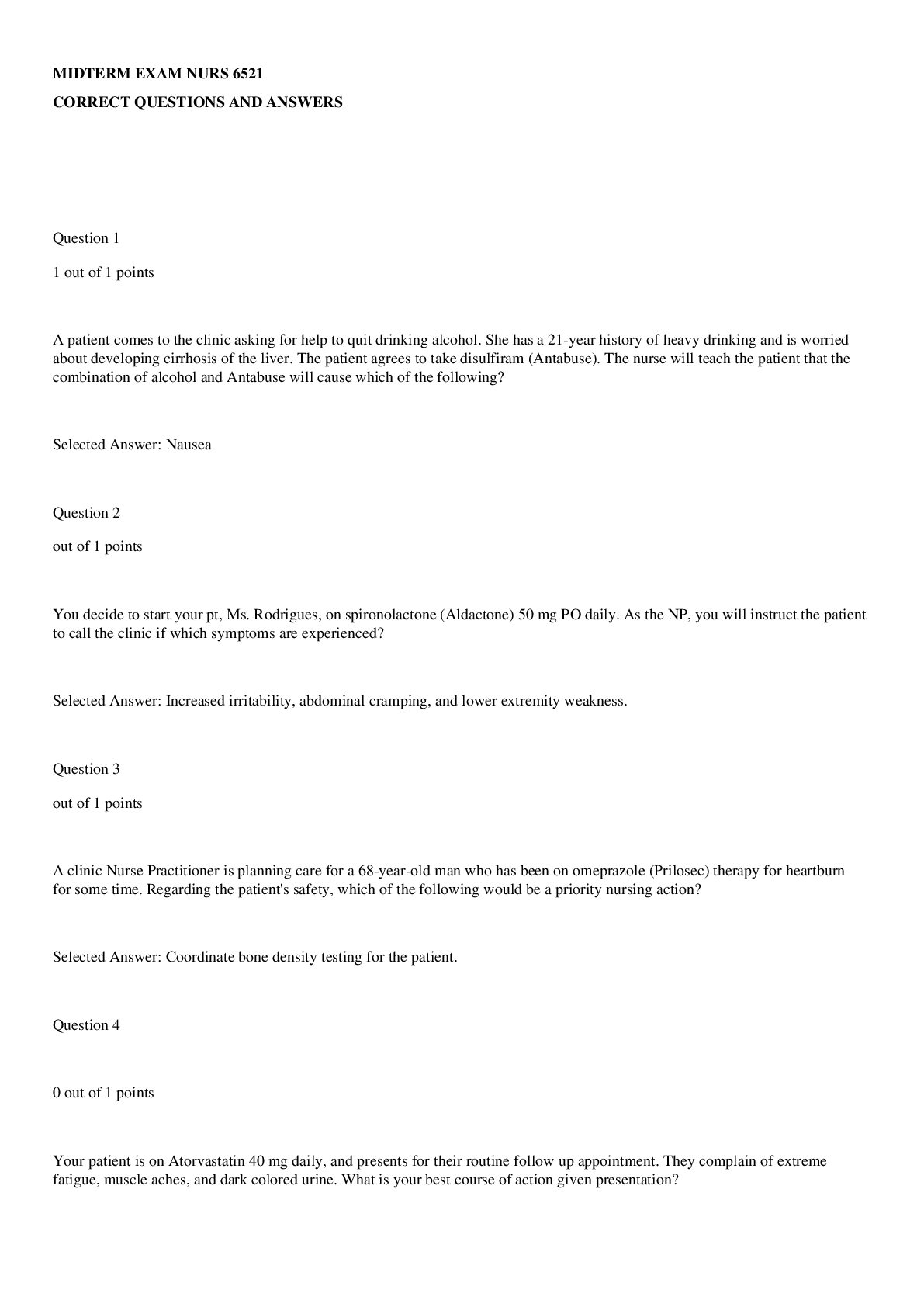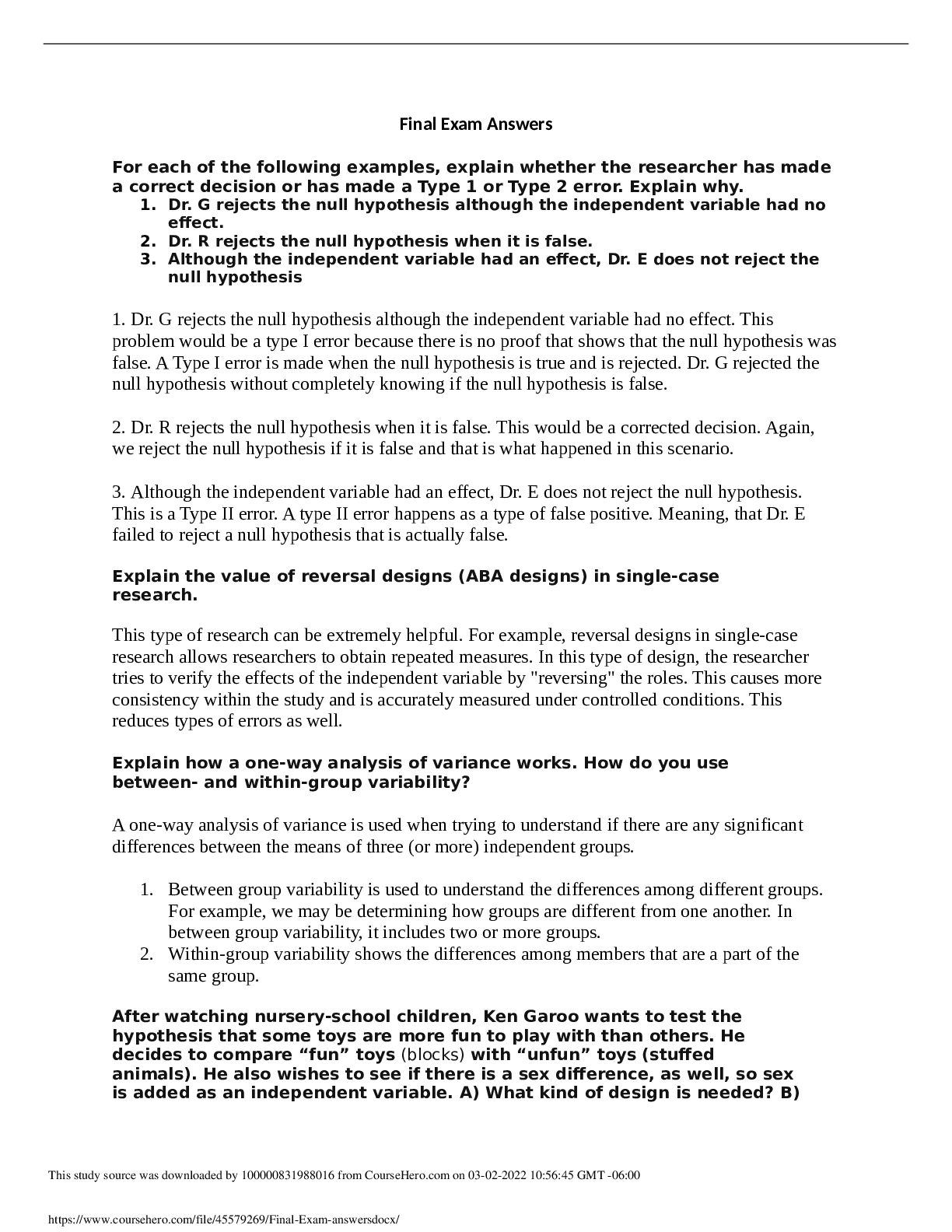NUR 104 - Week 7 Exam Prep Question and Answers,100% CORRECT
Document Content and Description Below
NUR 104 - Week 7 Exam Prep Question and Answers QUESTION 1 The RN identifies which patient is most at risk for drug toxicity? A 45-year-old patient with impaired renal function A 50-year-old... patient who has not voided in 12 hours A 60-year-old patient who took medication on an empty stomach A 40-year-old patient who has chronic constipation Student Feedback: Review how medications are excreted from the body in Treas, pages 781. Reference: Treas, L., Wilkinson, J., Barnett, K. & Smith, M. (2018). Basic nursing: Thinking, doing, and caring (2nd ed). Philadelphia, PA: F.A. Davis. Pg. 775-784, 781 Rationale: As kidneys are primary source of excretion for medications, patients with decreased renal function are at risk for toxicity. What is the RN’s initial action when reviewing a medication order that reads, “Colace, 30cc, by mouth every morning”? Call the prescriber and ask them to rewrite the order. Administer the medication to the patient as ordered. Clarify the desired time with the ordering prescriber. Ask the charge nurse what time to administer the medication. Student Feedback: Review the abbreviations that are dangerous in Treas, page 790 Reference: Treas, L., Wilkinson, J., Barnett, K. & Smith, M. (2018). Basic nursing: Thinking, doing, and caring (2nd ed). Philadelphia, PA: F.A. Davis. Pg. 790 Rationale: The Joint Commission has a “Do Not Use” list of abbreviations, including “cc” as unsafe. Which serum drug level is obtained 30 minutes prior to administration of a drug? Concentration of medication that produces desired effect without toxicity. Highest concentration of medication in serum. Lowest concentration of medication in serum. Toxic concentration levels of the medication. Student Feedback: Review peak and trough levels of drugs in Treas, page 782 and Lehne’s pages 39 -40. Reference: Burchum, J. R., & Rosenthal, L.D. (2019). Lehne’s pharmacology for nursing care (10th ed.). St Louis, MO: Elsevier. Pg. 39-40 Treas, L., Wilkinson, J., Barnett, K. & Smith, M. (2018). Basic nursing: Thinking, doing, and caring (2nd ed). Philadelphia, PA: F.A. Davis. Pg. 782 Rationale: The trough level is the lowest concentration of the medication. Which medication order requires clarification with the prescribing physician? Nicoderm transdermal 21 mg/day apply at 0800 Amoxicillin 125 mg in 5 mL orally every 8 hours Levothyroxine 100 micrograms intravenous push at 0700 Regular insulin 32 u subcutaneous before lunch Student feedback: Review the abbreviations that are dangerous in Treas, page 789- 792. Reference: Treas, L., Wilkinson, J., Barnett, K. & Smith, M. (2018). Basic nursing: Thinking, doing, and caring (2nd ed). Philadelphia, PA: F.A. Davis. Pg. 789-792 Rationale: Units must be written out, is considered a dangerous abbreviation per The Joint Commission A patient receiving intermittent infusions of tobramycin has a serum blood level drawn 60 minutes after the end of the intravenous infusion. What does this serum concentration tell the RN? The rapid minimum concentration. The highest plasma concentration. The lowest plasma concentration. The therapeutic index of the drug. Student feedback: Review drug levels in plasma in Burchum, pages 39-40. Reference: Burchum, J. R., & Rosenthal, L.D. (2019). Lehne’s pharmacology for nursing care (10th ed.). St Louis, MO: Elsevier. Pg. 39-40 Rationale: The peak serum drug level is taken once a drug’s absorption is complete. The peak level will depend on the individual drug and the route in which it was administered. The peak level is the highest concentration serum level of a drug Which patient outcome is appropriate for medication safety? The patient will learn when to take the medications at home. The patient will demonstrate how to use a metered dose inhaler. The patient will demonstrate the correct method for insulin injection by tomorrow. The patient will understand the use of the nebulizer by the end of the visit. Student feedback: Review planning outcomes/evaluation in Treas, page 797. Review of prior outcome guidelines will help also page 84-85 in Treas. Reference: Treas, L., Wilkinson, J., Barnett, K. & Smith, M. (2018). Basic nursing: Thinking, doing, and caring (2nd ed). Philadelphia, PA: F.A. Davis. Pg. 797 Rationale: measurable C is measurable, specific and has a time frame. Learn (a) and Understand (d) are not measurable. A and B do not include time frames. The medication order reads: acetaminophen (Tylenol) 240 mg oral suspension now. The pharmacy label reads: acetaminophen 160 mg per 5 mL. How many mL will the RN administer? Record your answer as a number using decimals if necessary (for example write 0.5 instead of ½). Do not include words or abbreviations in your answer. Reference: Treas, L., Wilkinson, J., Barnett, K. & Smith, M. (2018). Basic nursing: Thinking, doing, and caring (2nd ed). Philadelphia, PA: F.A. Davis. Pg. 787-788 (Calculating Dosages) [x] mL Correct Answer: x = 7.5 Ordered/ have x mL = X 240 mL/160 mL x 5 mL = 7.5 mL Student feedback: Review calculation formulas such as Desired dose X Quantity on hand = Desired Quantity Available dose Review Treas page 788. Which factors increase the older adult’s incidence of medication non- adherence? Select all that apply. Polypharmacy Difficulty opening containers Complex dosing schedules Increased visual acuity Decreased kidney function Student feedback: Review administering mediations to older adults in Treas, pages 801-802. Reference: Treas, L., Wilkinson, J., Barnett, K. & Smith, M. (2018). Basic nursing: Thinking, doing, and caring (2nd ed). Philadelphia, PA: F.A. Davis. Pg. 796, 801-802 Burchum, J. R., & Rosenthal, L.D. (2019). Lehne’s pharmacology for nursing care (10th ed.). St Louis, MO: Elsevier. Pg. 96-98 Rationale: The fact of having too many medications to remember, the high cost of medications and a decrease in manual dexterity can affect medication adherence negatively. Decreased visual acuity can negatively affect medication adherence. Kidney function has not proven to affect medication adherence as a primary cause. Which intervention by the RN will be most effective when working with a patient who is on multiple medications and is forgetting to take some of them? Encourage the family to administer medications to the patient. Teach the purpose of all of the medications to the patient. Develop a chart indicating times to take medications. Encourage the patient to use one pharmacy for all medication. Student Feedback: Review patient education and tips on taking medications in Treas, page 797-798 Reference: Treas, L., Wilkinson, J., Barnett, K. & Smith, M. (2018). Basic nursing: Thinking, doing, and caring (2nd ed). Philadelphia, PA: F.A. Davis. Pg. 797-798 Rationale: Developing a chart would be most appropriate to increase adherence. Which nursing intervention is the priority when an error in medication administration occurs? Report it to the nursing supervisor. Notify the prescriber of the medication. Document the medication was given in the patient record. Perform an assessment related to the medication that was given. Student Feedback: Review steps to take if a medication error is made in Treas, pages 795. Reference: Treas, L., Wilkinson, J., Barnett, K. & Smith, M. (2018). Basic nursing: Thinking, doing, and caring (2nd ed). Philadelphia, PA: F.A. Davis. Pg. 793-796, 819 (referred from 795) Rationale: The first step is to assess the patient. Which nursing intervention is a priority when administering a medication to a patient with an elevated serum creatinine level? Measure intake and output. Increase the patient’s fluid intake. Request a smaller dose of the prescribed medication. Monitor for signs of medication toxicity. Student feedback: Review effect of renal problems on drug excretion in Burchum, page 38-39 and Treas , page 785. Reference: Burchum, J. R., & Rosenthal, L.D. (2019). Lehne’s pharmacology for nursing care (10th ed.). St Louis, MO: Elsevier. Pg. 38-39 Treas, L., Wilkinson, J., Barnett, K. & Smith, M. (2018). Basic nursing: Thinking, doing, and caring (2nd ed). Philadelphia, PA: F.A. Davis. Pg. 785 Rationale: Decreased excretion with diminished kidney function may result in toxic drug levels. When conducting a focused medication assessment, which question asked by the RN provides information about medication adherence? “Where are your medications stored at home?” “Do you use any non-medicinal drugs?” “Have your medications had the expected effects?” “Are there problems that prevent you from taking your prescribed medicine?” Correct Answer: d Student Feedback: Review factors that make a patient likely to not take ordered medications in Treas, page 796-797. Reference: Treas, L., Wilkinson, J., Barnett, K. & Smith, M. (2018). Basic nursing: Thinking, doing, and caring (2nd ed). Philadelphia, PA: F.A. Davis. Pg. 796-797 Rationale: The other options are used in a focused med assessment but not to address adherence. Which intervention should the RN implement when a patient declines a prescribed medication? Encourage the patient take the medication. Ask a family member to give the medication to the patient. Change the administration time to coincide with a meal. Determine the reason for the refusal and document it. Student Feedback: Reviewing patient action concerning ordered medications can help with determining adherence in Treas, page 796. Reference: Treas, L., Wilkinson, J., Barnett, K. & Smith, M. (2018). Basic nursing: Thinking, doing, and caring (2nd ed). Philadelphia, PA: F.A. Davis. Pg. 796 Rationale: It is important to determine the reason for the refusal to assist the patient to accept the medication. Which statement made by the patient indicates to the RN that additional instruction about taking prescribed medications is necessary? “I will take my medications at the same time every day.” “I will call the physician if there are any side effects.” “I should take my medications onto the airplane with me when traveling.” “I can use my spouse’s supply since we are taking the same medication.” Student feedback: Review teaching patients about self- administration of medications in Treas, page 797. Reference: Treas, L., Wilkinson, J., Barnett, K. & Smith, M. (2018). Basic nursing: Thinking, doing, and caring (2nd ed). Philadelphia, PA: F.A. Davis. Pg. 797 Rationale: Using another person’s medication increases the risk for error because drug dilution or dosage may not be the same. A patient asks about disposal of medications in the home setting. Which is the RN’s appropriate response? “Check with your local pharmacy for return disposal.” “Dilute medications with bleach before disposal.” “Pour all medications down the drain in the sink.” “Pulverize all tablets before disposal in the toilet.” Student feedback: Review disposal of medications in Treas, page 797. Reference: Treas, L., Wilkinson, J., Barnett, K. & Smith, M. (2018). Basic nursing: Thinking, doing, and caring (2nd ed). Philadelphia, PA: F.A. Davis. Pg. 797-798 Rationale: The only correct statement is A. Medications should not be poured down the drain as this is an environmental hazard. For which of these patients should the RN assessment of medications include the Beers’ List and comparing it to the patient’s medications? An infant with cystic fibrosis A teenager with multiple trauma An adult with diabetes mellitus An elder with parkinsonism Student Feedback: Review Beers list and who is identified for possible adverse drug reactions with this list, in Burchum, page 95-96. Reference: Burchum, J. R., & Rosenthal, L.D. (2019). Lehne’s pharmacology for nursing care (10th ed.). St Louis, MO: Elsevier. Pg. 95-96. Rationale: The Beer’s List identifies drugs that are highly likely to cause adverse side effects in people over 65 years of age. What action should the RN use to promote adherence with bitter tasting oral medications for a young school-aged child? Select all that apply. Give child a frozen treat before giving oral medication Give child a sticker for successfully taken the medications Disguise medication in an essential food the child likes Disguise medication in an essential liquid the child likes Tell them that it will taste good and to take it quickly. Student feedback: Review strategies to enhance child’s taking oral medicine in Burchum, page 92-93. Reference: Burchum, J. R., & Rosenthal, L.D. (2019). Lehne’s pharmacology for nursing care (10th ed.). St Louis, MO: Elsevier. Pg. 92-93 Rationale: A frozen treat may numb the oral cavity and decrease the sense of taste. Using a sticker system for rewards may help child accept the medication. Disguising the medication in an essential food or fluid may cause child to avoid that food or fluid. Lying to the child with cause distrust. The RN is reviewing medication orders. Which of these abbreviation(s) will cause the RN to question the order? Select all that apply. cc ug mL mcg PO Student feedback: Review the abbreviations that are dangerous in Treas, page 789- 792. Reference: Treas, L., Wilkinson, J., Barnett, K. & Smith, M. (2018). Basic nursing: Thinking, doing, and caring (2nd ed). Philadelphia, PA: F.A. Davis. Pg. 790-792 Rationale: “cc” and “ug” are abbreviations on the Institute for safe Medication Practices (ISMP) listed as error-prone abbreviations to be avoided. The rest are appropriate. Which of these patients should the RN expect the medication dosage order to be based upon weight of the patient? A patient with orthopedic surgery An elderly patient with heart disease A 9-month-old with gastrointestinal disease An adult with reoccurrence of cancer Student feedback: Review calculating dosed of drugs in Treas, page 788. Reference: Treas, L., Wilkinson, J., Barnett, K. & Smith, M. (2018). Basic nursing: Thinking, doing, and caring (2nd ed). Philadelphia, PA: F.A. Davis. Pg. 788 Rationale: The child is the one patient for whom drug ordered doses would utilize weight consistently. A patient with panic attacks has been prescribed: alprazolam (Xanax) 0.75mg orally 3 times a day. The pharmacy label reads: How many tablets per dose will the RN administer? Record your answer as a number using decimals if necessary (for example write 0.5 instead of ½). Do not include words or abbreviations in your answer. Student feedback: Review calculation formulas such as Desired dose X Quantity on hand = Desired Quantity Available dose Review Treas page 788. Quiz Score: 100 out of 100 [Show More]
Last updated: 1 year ago
Preview 1 out of 27 pages
Instant download

Buy this document to get the full access instantly
Instant Download Access after purchase
Add to cartInstant download
Reviews( 0 )
Document information
Connected school, study & course
About the document
Uploaded On
Oct 14, 2021
Number of pages
27
Written in
Additional information
This document has been written for:
Uploaded
Oct 14, 2021
Downloads
0
Views
27













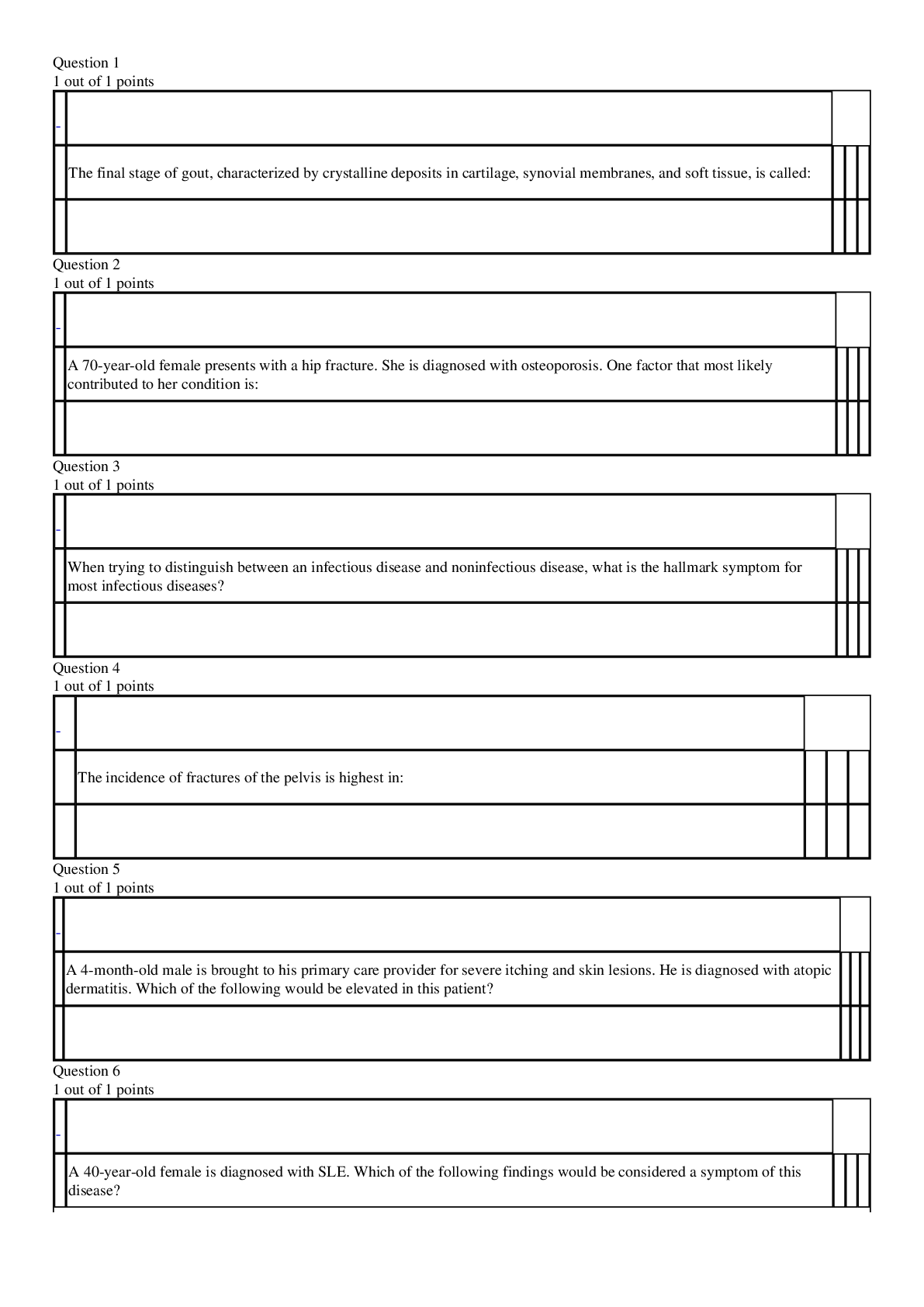
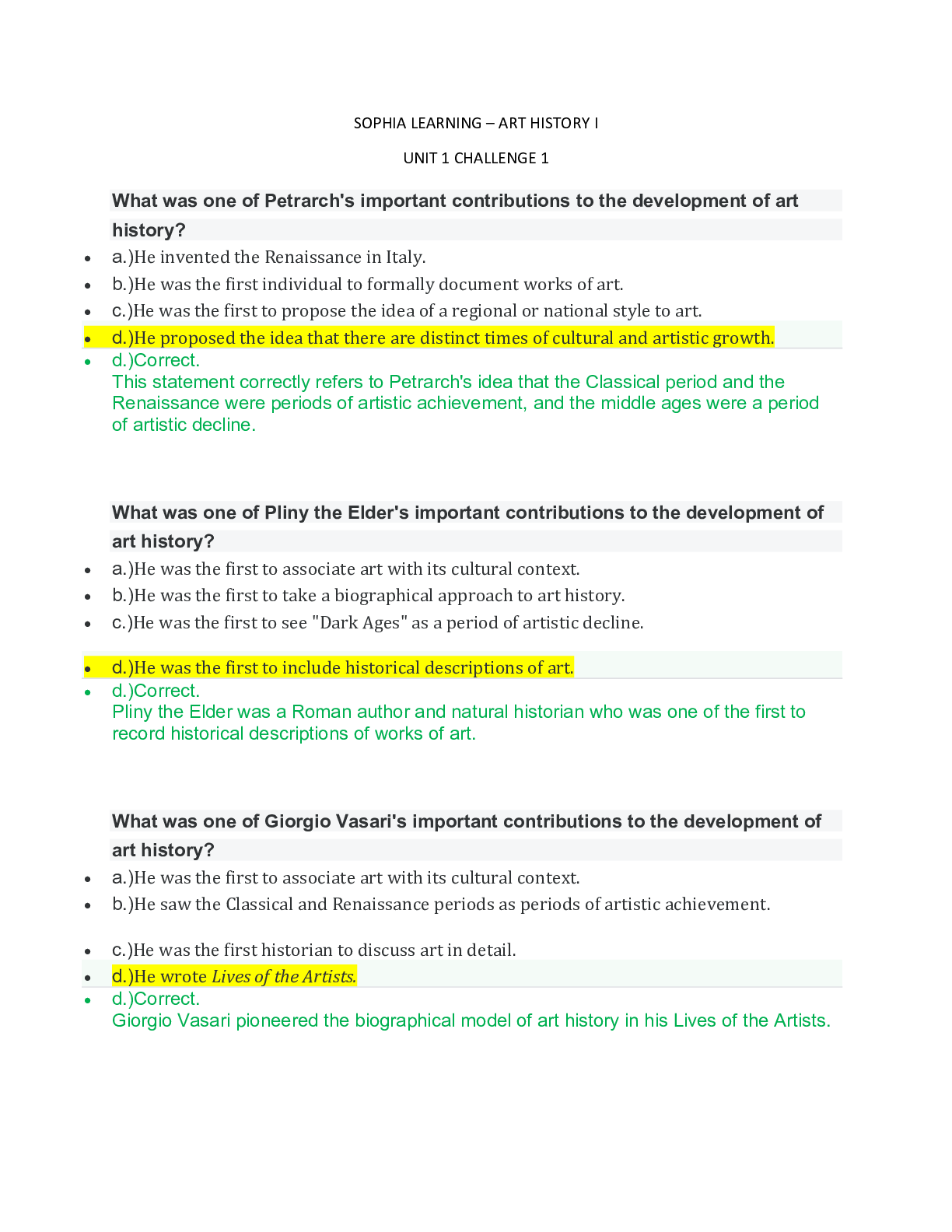
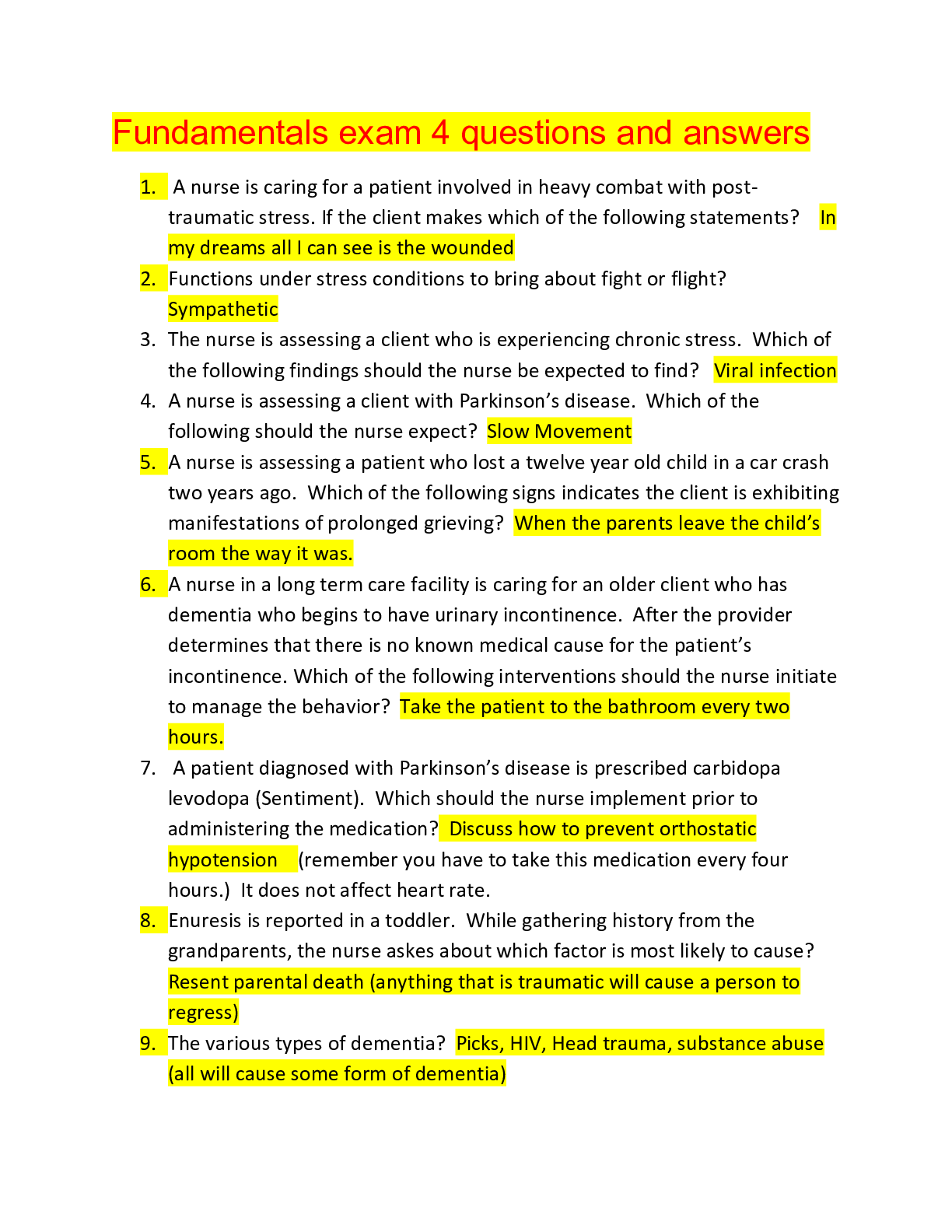
 – American Academy of Professional Coders.png)

